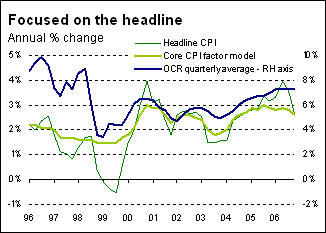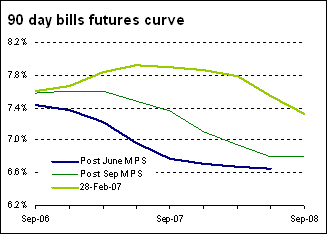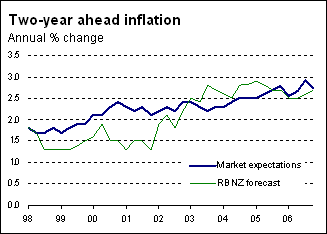A soft spot for a tough policy change
Annual average GDP growth is at a seven-year low, but economic forecasters appear to have broadly accepted the Reserve Bank’s commitment to raising interest rates higher. This combination suggests to us that the Reserve Bank has explicitly grown less accepting of medium-term inflation pressure, and that it has largely convinced the market that an aggressive stance is necessary.
In justifying the "likely" need for a rate increase in March, the Reserve Bank pointed to a "resurgent housing market" and a rebound in domestic demand. Business confidence and consumer confidence, which tend to be good leading indicators of activity, have both improved to multi-year highs.
However, the Reserve Bank could be accused of cherry-picking the data. Some of the "big" statistical measures show continuing weakness in the economy. The economy grew at an annualised rate of just 1.2% over the last two quarters, there was no employment growth over the same period, and despite a strong result in the December quarter, growth in retail activity has weakened substantially over the last year (in accordance with the Bank’s intentions). Crucially, headline inflation, and measures of core inflation, have both eased recently (see Graph 9.1).
Historically, there has been a strong link between headline rates of inflation and contemporaneous interest rate decisions. This relationship is not purely reactionary — the Reserve Bank’s inflation forecasts emphasise the role of inflation expectations in determining future inflation outcomes, and expectations are themselves conditioned on current inflation levels. But it does suggest that the Bank has tended to focus more on short-term than medium-term inflation (despite its mandate for the latter).

Graph 9.1
With that in mind, a decision to raise rates during a period of falling headline inflation would be highly abnormal (especially with a backdrop of weak economic growth). It is somewhat surprising, then, that this move has been met with a begrudging acceptance by financial markets. In contrast, the Reserve Bank received sharp criticism when it last raised interest rates in December 2005.
We take two things from this. Firstly, it is clear that the consensus outlook for New Zealand has improved sharply — it is widely accepted that the economy is robust enough to raise rates without risking a recession.
Secondly, the Reserve Bank has toned up its communication skills. With hindsight, it is clear that the last four policy statements have built a consensus in favour of higher interest rates. The Bank has shaped the discussion by concentrating on the bullish economic indicators, although an alternative and equally plausible campaign for easier policy could have been mounted by focusing on the indications of economic weakness. Leading the market by the nose has allowed the Bank to more effectively shape interest rate expectations and thus the yield curve (see Graph9.2).

Graph 9.2
Why now?
To what aim has the Reserve Bank shifted market opinion? The best explanation for increasing rates now, even as headline inflation is starting to ease, is that the Bank is putting a greater emphasis on the medium-term inflation risk (as revealed by the increasing number of references to "medium-term" in recent policy statements).
With a starting point of uncomfortably high inflation expectations and little spare capacity, the Bank knows that are acceleration in economic growth threatens to cement medium-term inflation at around 3%pa. This should be an unacceptable outcome for the Bank, given that their inflation target implies average inflation of 2%pa. However, judging by the Reserve Bank’s own forecasts of future inflation, their adherence to that policy goal appears to have weakened substantially in recent years.[1]
It is highly problematic for the Bank to tolerate medium-term inflation outcomes between 2.5% and 3%pa, as the Bank has been forecasting for the last three years, while notionally committing to a medium-term upper limit on inflation of 3%pa. With so little headroom to manoeuvre, the Bank is forced to either be more tolerant of (inevitable)inflation outcomes above 3%pa, or to respond more aggressively to new inflationary threats. Neither is an optimal policy approach.

Graph 9.3
Building the case now for a stronger medium-term focus is a convenient way of ignoring the short-term impact from lower petrol prices, a rising dollar, and earlier economic weakness (the combined effect will be to push headline inflation temporarily below 2%), which would normally create public pressure for interest rate cuts.
However, there can be little doubt that there is a genuine need for the Reserve Bank to reverse the trend towards ever higher rates of medium-term inflation. With short-term economic indicators now looking more promising, the Reserve Bank may very well judge that the economy is fundamentally sound enough to bear a sustained push of tighter monetary policy with the aim of stamping out inflation.
1 For further discussion of this point, see David Grimmond, "Does the Reserve Bank spend too much time looking in the rear-viewmirror?".






